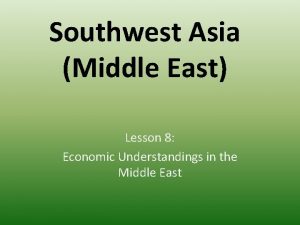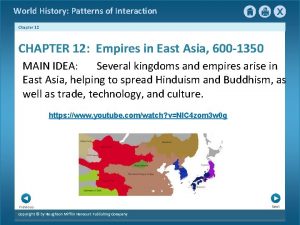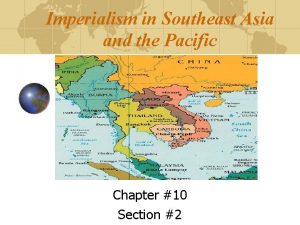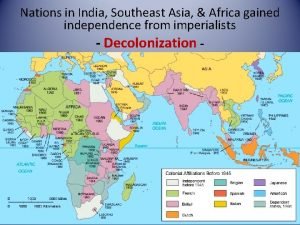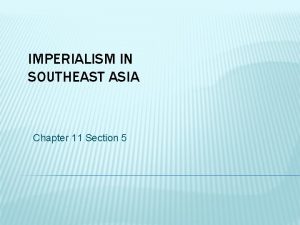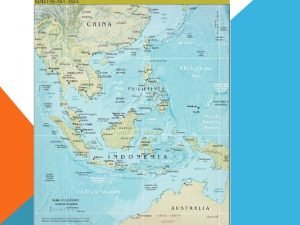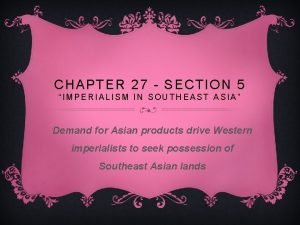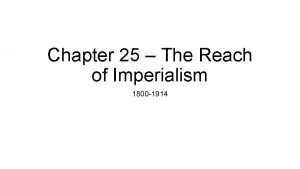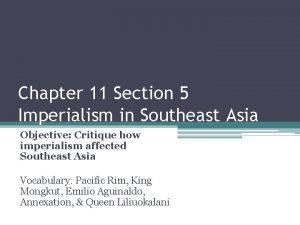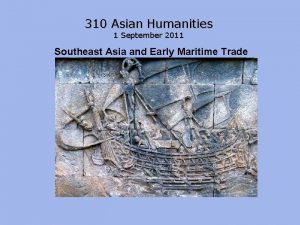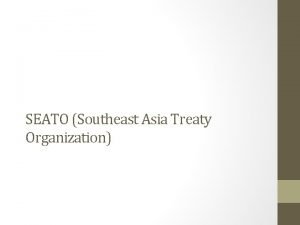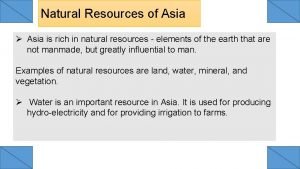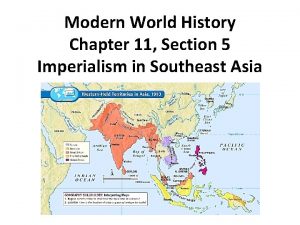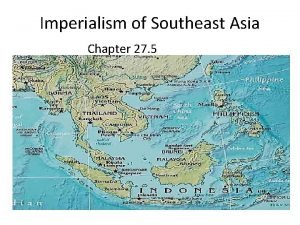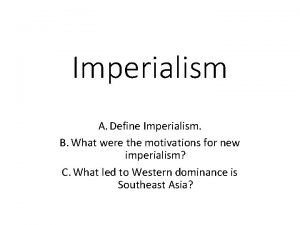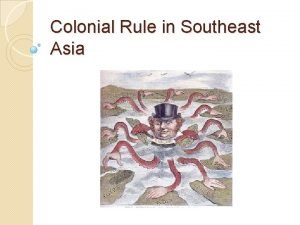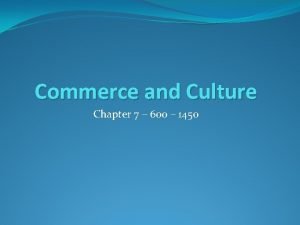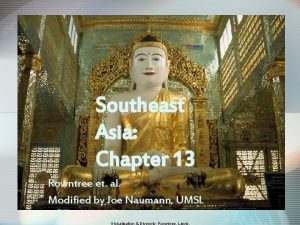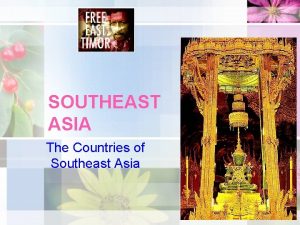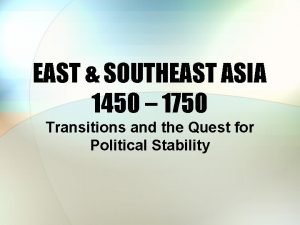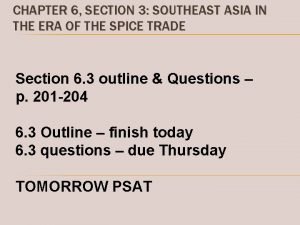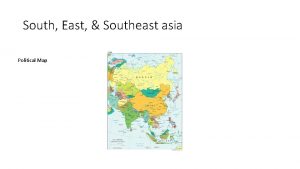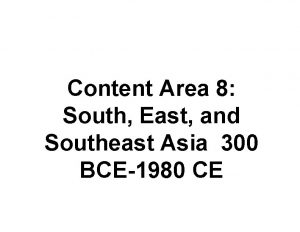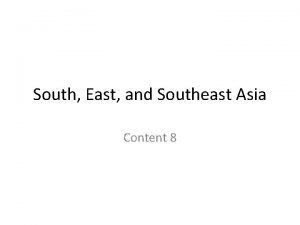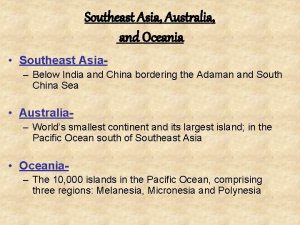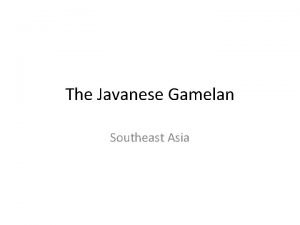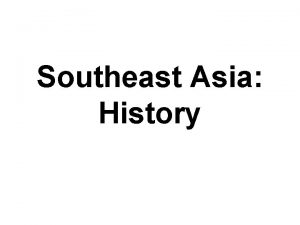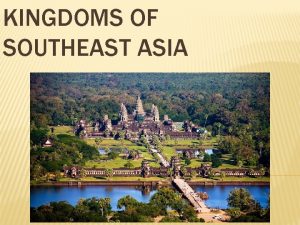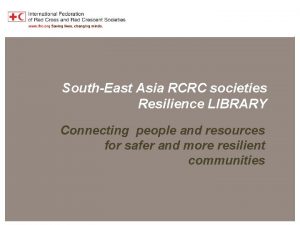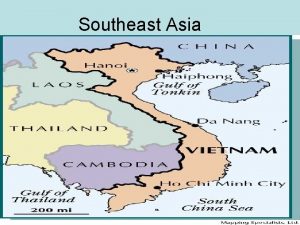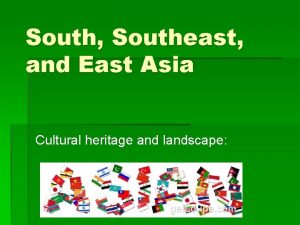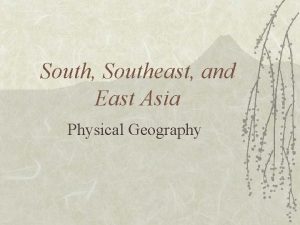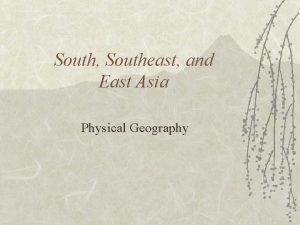Content Area 8 South East and Southeast Asia




























![The painting-turned-poster Mao zhuxi qu Anyuan [毛主席去安源, Chairman Mao goes to Anyuan] became a The painting-turned-poster Mao zhuxi qu Anyuan [毛主席去安源, Chairman Mao goes to Anyuan] became a](https://slidetodoc.com/presentation_image_h2/cac869a95892101c4ebb030edfb63b7b/image-29.jpg)
- Slides: 29

Content Area 8: South, East, and Southeast Asia 300 BCE-1980 CE

192. Great Stupa at Sanchi, Madya Pradesh, India. Buddhist; Maurya Period, late Sunga Dynasty c. 300 BCE-100 CE Stone masonry, sandstone on dome. (4 images). Form Masonry, stone. sandstone Content Placed on a hill, location of relics of Buddha, stupas can be various sizes Function to house relics of Buddha Context People come to the location to honor Buddha, no images of him are seen here. Walk in clockwise direction around the stupa Themes Scared space Religious worship Terms stupa North Gate

193. Terra cotta warriors from the mausoleum of the first Qin emperor of China. Qin Dynasty c. 221 -209 BCE Painted terra cotta (2 images) Form Terracotta, life size Function tomb Themes funerary Content Life sized figures, chariots, horses, army of figures to protect. Context: emperor Qin Shihuang (became emperor at 13) was responsible for unifying China. He was obsessed with immortality, built the mausoleum to parallel his life on earth. Underground Terms army Mausoleum

194. Funeral banner of Lady Dai (Xin Zhui). Han Dynasty, China. c. 180 BCE Painted Silk. Form 6 ft long silk banner Function: funerary Themes: Funerary Terms Hunan Provincial Museum, Changsha Content: arranged in registers: heavenly realm, Lady Dai & attendants, body of Lady Dai & mourners, underworld. Context: believed afterlife important, buried with lavish objects, found in preserved tomb. Possibly a “name banner” to identify the dead. Early example of pictorial art in China. Earliest known portrait painting in Chinese history. Dai was wife of high ranking official

195. Longmen caves. Luoyany, China. Tang Dynasty. 493 -1127 CE Limestone (3 images) Form Function Themes Content: 2300 caves, 100, 000 statues, filled with Buddhist art. 1 mile long. Central relief is Buddha 45 feet tall. Context: Buddhism born in India but transmitted through China. Shows serene majesty of Buddha and monumetal simplicity of the figure Terms 3 rd image next slide


196. Gold and jade crown. Three Kingdoms Period, Silla Kingdom, Korea. 5 th to 6 th century CE metalwork Gold and jade Form Content Function Context Themes Terms Gyeongju National Museum, Korea

197. Todai-ji. Nara, Japan. Various artists, including sculptors Unkei and Keikei, as well as the Kei School. 743 CE; rebuilt c. 1700. Bronze and wood (sculpture); wood with ceramic roofing (architecture). 5 images Form Oldest wooden temple Content Great Eastern Temple, once burned don but rebuilt in 710. Function Temple Buddhist Context: japan wanted to match the grandeur of art and arch of China and Korea, so they imported some features. Large Buddha is associated with Cosmos and sun Themes Terms

198. Borobudur Temple. Central Java, Indonesia. Sailendra Dynasty. c. 750 -842 CE Volcanic-stone masonry Content 504 statues f Buddha, (3 images) 3 D mandala: series of passage ways that radiate clockwise Form around a central axis. 72 stuppas. Worlds largest Buddhist temple. Resembles a pyramid Function Shrine, stupa, temple, reliquary Themes Context: based on 3 spheres: Desire, Forms, Formlessness. Narratives throughout illustrate the life of Buddha and path to enlightenment. Terms

199. Angkor, the temple of Angkor Wat, and the city of Angkor Thom, Cambodia. Hindu, Angkor Dynasty. c. 800 -1400 CE Stone masonry, sandstone. (5 images) really 6 Content: surrounded Form by motes, combined Hindu and Buddhist temple with shaman practices. Reliefs around tell Hindu stories (showing good Function South Gate Angkor Thomover evil) Shrine Context: dedicated to observatory Vishnu, possible that Funerary temple also serves as mausoleum for king. Viewed as a home for the gods, not a place Themes of worship Terms

200. Lakshmana Temple. Khajuraho, India. Hindu, Chandella Dynasty, c. 930 -950 CE Sandstone (4 images). Content: covered with images of 600+ gods, some erotic images. Main shrine faces east flanked by sub shrines Form Function Hindu temple Themes Sacred space fertility Terms Context Dedicated to Vishnu, must look at reliefs as you walk clockwise around, also had fertility images. Hindu temples were seen as the home of the gods on earth and a place where they make themselves visible. Not for congregation. Only priests may enter the inner chamber with offerings.

201. Travelers among Mountains and Streams. Fan Kuan. c. 1000 Ink and colors on silk. Form: scroll ink on silk Function: decorative, inspired future Chinese Landscape Themes Nature landscape Content: Use of scale, shows vastness of nature embodying human existance Context: Fan Kuan was a Daoist during the Song period. A combo of Buddhist and Confuscian philosophy Terms Daoism Neo-Confusionism National Palace Museum, Taipei

http: //www. npm. gov. tw/en/Article. aspx? s. No=04000 Use website for close ups of painting

202. Shiva as Lord of Dance (Nataraja). Hindu; India (Tamil Nadu), Chola Dynasty. c. 11 th century CE Cast Bronze Form Function: unsure of desired placement. Used in procession Content dancing shiva inside flaming ring/halo, right hand holds a drum, left hand a flame, lower hands show fear. Stomping on a figure that refers to illusion, which leads man astray. Medieval India. When worshiper prays before statue, faith activates it and Shiva is present Themes Context: represents the never-ending cycle of time. Through belief in Shiva, you can achieve salvation Terms Metropolitan Museum of Art, NYC

From MET website

203. Night Attack on the Sanjo Palace. Kamakura Period, Japan. c. 1250 -1300 CE Handscroll (Ink and color on paper) (2 images) Form 18 feet long Function History painting of battle Themes Content shows mayhem, violence and palace on fire, birds eye view meant to be read right to left. Context about battle over power between emperor and head of clan. History painting, designed to be read while being unscrolled Terms

204. The David Vases. Yuan Dynasty, China. 1351 CE White porcelain with cobalt-blue underglaze. Form Content: named after the collector, dragon, phoenix, elephant, inscription with date and purpose Function: dedicated to daoist temple as an offering Themes British Museum Terms Context: made for altar of Daoist temple, blue and white porcelain was being produced as inscription states, demonstrates the skill and beauty of Chinese ceramics, made for imperial courts, domestic market and export. Shows Iranian influence (Blue and subject matter)

They were made for the altar of a Daoist temple and their importance lies in the dated inscriptions on one side of their necks, above the bands of dragons. The long dedication is the earliest known on Chinese blue-and-white wares. The dedication records that in AD 1351 a man named Zhang Wenjin from Yushan county presented these two vases and an incense burner (the whereabouts of which is unknown), to a Daoist temple in Xingyuan (modern day Wuyuan county). Yushan county is in northeast Jiangxi, which lies 120 km to the southeast of Jingdezhen, where these vases were made. This inscription demonstrates that blue-and-white porcelain production was already well-established at Jingdezhen by AD 1351. Originally the vases, modelled after bronzes, had porcelain rings attached through the elephant head shaped handles. Porcelain was first produced in China around AD 600. The skillful transformation of ordinary clay into beautiful objects has captivated the imagination of people throughout history and across the globe. Chinese ceramics, by far the most advanced in the world, were made for the imperial court, the domestic market, or for export. These vases were owned by Sir Percival David (1892– 1964), who built the most important private collection of Chinese ceramics in the world. From British Museum Website

205. Portrait of Sin Sukju (1417 -1475) Imperial Bureau of Painting. c. 15 th century CE Hanging scroll (ink and color on silk). Form Function: Korean Royal portrait Content: portrait of scholar and one time Korean prime minister, face detailed but sharp angular blocks of color elsewhere. Badge with rank on chest Context: official portrait, intended to show a likeness of the person, more attention to face Themes Terms

The establishment of the Joseon ("Fresh Dawn") dynasty in 1392, following a revolutionary yet bloodless coup, purged the corrupt practices of the Goryeo regime, ended Mongol domination, and fueled an extraordinary cultural renaissance. The new political vision of the state promoted Neo-Confucianism in both theoretical explorations and practical implementation in nearly every aspect of society. Buddhism, the state-sanctioned religion for more than a thousand years, was officially rejected, though private worship and artistic production continued. The Neo-Confucian royal court and eliterati (yangban), the primary patrons of the arts, embraced and encouraged the advancement of secular art and culture. The fifteenth and sixteenth centuries witnessed the revival and reinterpretation of classical traditions alongside significant achievements in innovative art forms. Under King Sejong (r. 1418– 50), who was the embodiment of a renaissance monarch, a unique, phonetic alphabet (hangeul) was created, permitting an accurate transcription of the native language and the wide dissemination of Confucian texts and mores.

206. Forbidden City. Beijing, China. Ming Dynasty. 15 th century CE and later. Stone masonry, marble, brick, wood, and ceramic tile (5 images). Form Content: vast complex 178 acres, took 20+ years to complete Function Themes Context: in 1420, to maintain control, the emperor moved capitol to beijing. Complex was only open to imperial family and those associated with it (aka “forbidden”) Terms

207. Ryoan-ji. Kyoto, Japan. Muromachi Period, Japan. c. 1480 CE; current design most likely dates to the 18 th century. Rock garden. (3 images). Form Spiritual complex Function Zen Buddhist complex Themes Content Context uses nature to enhance meditation, Japanese aesthetics, Zen= reach enlightenment through meditation Terms

208. Jahangir Preferring a Sufi Shaikh to Kings. Bichitr. c. 1620 CE watercolor, gold, and ink on paper. Form Content Function Context Themes Terms Freer Gallery of Art, Smithsonian Institution, Washington, DC

209. Taj Mahal. Agra, Uttar Pradesh, India. Masons, marble workers, mosaicists, and decorators working under the supervision of Usted Ahmad Lahori, architect of the emperor. 1632 -1653 CE Stone masonry and marble with inlay of precious and semiprecious stones; gardens (2 images). Form Monumental tomb Function Funerary mausoleum Content. Islamic tradition, dome on cube, appears weightless, floats above reflective pools, proportionof horizontal and vertical are balanced Context Shah Jahan built as memorial to his wife Mumtaz Mahal, tomb is empty Themes Terms Cenotaph- empty tomb

210. White and Red Plum Blossoms. Ogata Korin. c. 1710 -1716 CE ink, watercolor, and gold leaf on paper (2 images) Form Content Function Context Themes Terms


211. Under the Wave off Kanagawa (Kanagawa ok nami ura), also knowns as the Great Wave, from the series Thirty-Six Views of Mount Fuji. Katsushika Hokusai. 1830 -1833 CE Polychrome woodblock print; ink and color on paper. Form Content Function Context Themes Terms Met Museum

212. Chairman Mao en Route to Anyuan. Artist unknown: based on an oil painting by Liu Chunhua. c. 1969 Color lithograph Form Content Function Context Themes Terms
![The paintingturnedposter Mao zhuxi qu Anyuan 毛主席去安源 Chairman Mao goes to Anyuan became a The painting-turned-poster Mao zhuxi qu Anyuan [毛主席去安源, Chairman Mao goes to Anyuan] became a](https://slidetodoc.com/presentation_image_h2/cac869a95892101c4ebb030edfb63b7b/image-29.jpg)
The painting-turned-poster Mao zhuxi qu Anyuan [毛主席去安源, Chairman Mao goes to Anyuan] became a cause celèbre, ". . . perhaps the most important painting of the Cultural Revolution period". It depicts Mao as a young man on his way to the city of Anyuan to lead a miners' strike. The work was explicitly promoted by Jiang Qing as a model painting equal to the model operas and ballets she espoused. As such it became the benchmark for the iconographical representation of Mao. The painting was made by Liu Chunhua, a Red Guard studying at the Central Academy of Industrial Arts, but it was collectively designed and planned by a group of students from universities and institutes in Peking. Liu explained how the painting was preconceived along ideological lines and invested with symbolic meaning: "To put him in a focal position, we placed Chairman Mao in the forefront of the painting, advancing towards us like a rising sun bringing hope to the people. Every line of the Chairman's figure embodies the great thought of Mao Zedong and in portraying his journey we strove to give significance to every small detail. His head held high in the act of surveying the scene before him conveys his revolutionary spirit, dauntless before danger and violence and courageous in struggle and in 'daring to win'; his clenched fist depicts his revolutionary will, scorning all sacrifice, his determination to surmount every difficulty to emancipate China and mankind and it shows his confidence in victory. The old umbrella under his right arm demonstrates his hard-working style of travelling, in all weather over great distances, across the mountains and rivers, for the revolutionary cause [. . . ] The hair grown long in a very busy life is blown by the autumn wind. His long plain gown, fluttering in the wind, is a harbinger of the approaching revolutionary storm [. . . ] With the arrival of our great leader, blue skies appear over Anyuan. The hills, sky, trees and clouds are the means used artistically to evoke a grand image of the red sun in our hearts. Riotous clouds are drifting swiftly past. They indicate that Chairman Mao is arriving in Anyuan at a critical point of sharp class struggle and show, in contrast http: //chineseposters. net/themes/mao-anyuan. php how tranquil, confident and firm Chairman Mao is at that moment [. . . ]. "
 Lesson 8 middle east and south asia
Lesson 8 middle east and south asia East south east wind direction
East south east wind direction Mainland southeast asia
Mainland southeast asia Chapter 12 section 5 kingdoms of southeast asia and korea
Chapter 12 section 5 kingdoms of southeast asia and korea Imperialism in southeast asia and the pacific
Imperialism in southeast asia and the pacific Southeast asia model
Southeast asia model Chapter 21 section 1 landforms and resources
Chapter 21 section 1 landforms and resources Is india southeast asia
Is india southeast asia Imperialism in southeast asia chapter 27 section 5
Imperialism in southeast asia chapter 27 section 5 Southeast asia climate
Southeast asia climate Chapter 11 section 5 imperialism in southeast asia
Chapter 11 section 5 imperialism in southeast asia Chapter 25 lesson 4 imperialism in latin america
Chapter 25 lesson 4 imperialism in latin america Chapter 15 lesson 1 physical geography of north africa
Chapter 15 lesson 1 physical geography of north africa Chapter 11 section 5 imperialism in southeast asia
Chapter 11 section 5 imperialism in southeast asia Southeast asian alphabets
Southeast asian alphabets Southeast asia treaty organization
Southeast asia treaty organization Is asia rich in natural resources
Is asia rich in natural resources Chapter 11 section 5 imperialism in southeast asia
Chapter 11 section 5 imperialism in southeast asia Imperialism in southeast asia chapter 27 section 5
Imperialism in southeast asia chapter 27 section 5 What led to western dominance in southeast asia
What led to western dominance in southeast asia Colonial rule in southeast asia
Colonial rule in southeast asia Buddhism and chinese culture
Buddhism and chinese culture Sea roads as a catalyst for change southeast asia
Sea roads as a catalyst for change southeast asia Countries in southeast asia
Countries in southeast asia Countries in southeast asia
Countries in southeast asia Seapil
Seapil Insular southeast asia
Insular southeast asia Southeast asia 1450 to 1750
Southeast asia 1450 to 1750 In 1500 mainland southeast asia was a relatively
In 1500 mainland southeast asia was a relatively The meeting of longitude and latitude lines
The meeting of longitude and latitude lines
